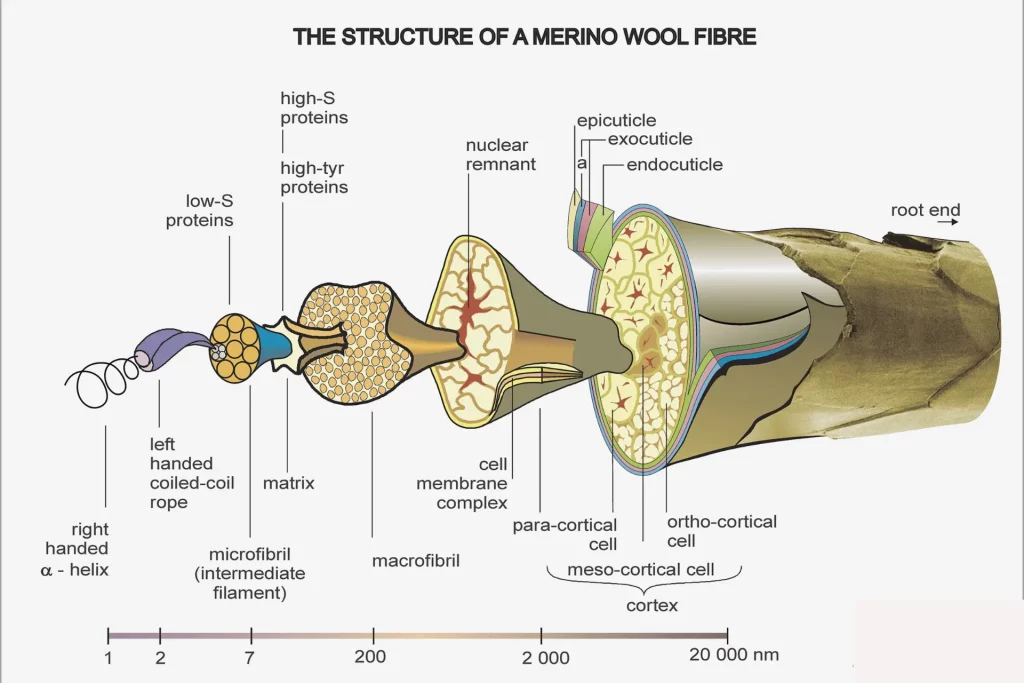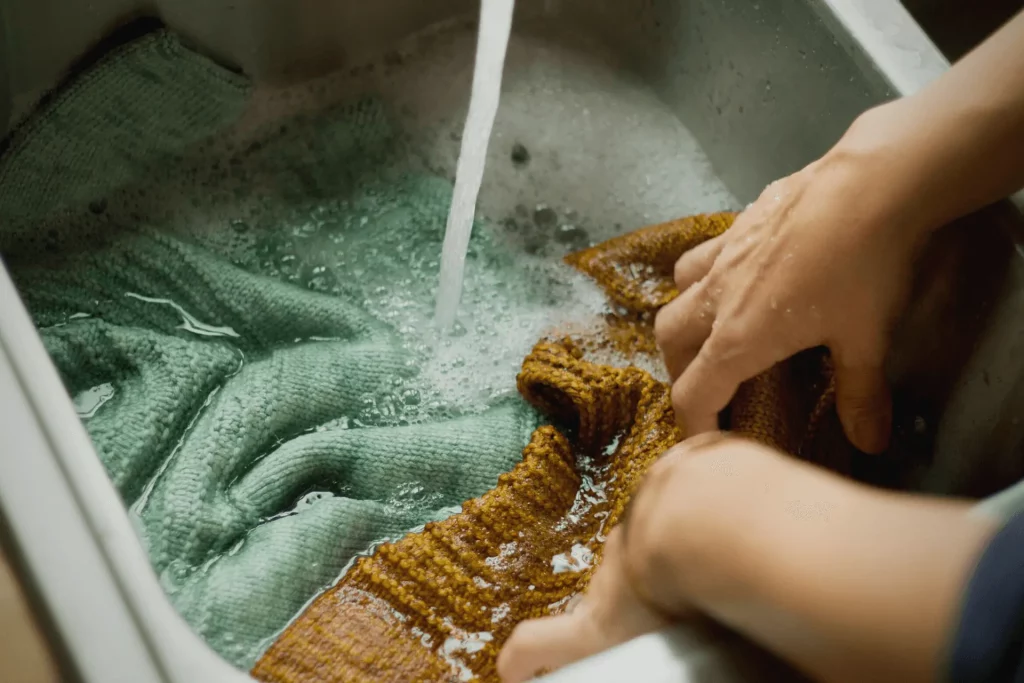Merino Wool is a one-of-a-kind material that is flexible and resistant to temperature changes. In addition to keeping you warm during the coelacanth ability to wick away perspiration and maintain your dryness throughout the warmer months.
The material is sustainable, renewable, and biodegradable, making it an eco-friendly explorer’s wildest fantasy for use in damp conditions. The benefits of Merino wool may be summed up as outstanding.
Even though Merino wool ticks all the boxes to be unique, it is vital to comprehend its science to appreciate its genuineness overall. Let’s explore the sheep pasture to learn more about the science behind Merino wool’s advantages and why it is such a popular choice for clothing fabric.
Table of Contents
Merino Wool Structure:

Merino wool is made of beautiful fibers, much finer than ordinary sheep’s wool. These fine fibers create a light, soft and luxurious fabric that doesn’t itch like traditional woolen materials.
Merino sheep produce this type of wool from their thick outer coat, which helps protect them from the elements while providing incredible insulation throughout the seasons.
The unique structure of merino wool gives it a range of physical properties – it’s naturally odor-resistant, highly breathable, and it wicks away moisture quickly to keep you feeling dry and comfortable all day long. It’s also resistant to dirt and can be easily machine-washed without losing shape or texture.
Merino wool is an ideal material for clothing and activewear, thanks to these fantastic properties. It’s perfect for those who enjoy outdoor activities such as hiking and camping, and it’s a great choice and excellent day wear too!
Benefits of Merino Wool:
Because it possesses so many beautiful features, Merino wool is an excellent option for various products, including apparel, bedding, and others. However, despite its suppleness and portability, it is exceptionally long-lasting.
Because it is both breathable and can maintain a consistent temperature, the material is ideal for use in extremely hot or cold environments. Because merino wool can naturally drain moisture, you won’t need to worry about sweating through your clothing, even if you wear it for a long time.
Because this fiber is far finer than regular sheep’s wool, it will not create the same amount of itching or irritation when worn against the skin as traditional sheep’s wool. Due to merino wool’s intrinsic strength and tenacity, garments made from this material may be expected to endure up to three times longer than those made from cotton.
Given all of these advantages, it is not surprising that merino wool has become such a well-liked material for producing clothing and bedding. If you take the necessary precautions, it should serve you well for a good number of years in addition to ensuring your comfort.
How Does Clothing Made Of Wool Manage To Be So Warm Yet Still So Lightweight?

Wool does not conduct heat away from the body, which is one of the primary reasons it may be used to keep a person warm. To put it another way, wool is not a very good heat conductor. This might be surprising, but it’s a very positive development.
The most common method by which heat is transferred from one material to another is called conduction, which you see in action daily, such as a skillet transmitting heat from a burner.
Due to its physical features, Wool does not absorb the heat that your body labors so hard to create when it is chilly outside. This prevents your body from having to work as hard to stay warm.
Therefore, you, rather than your clothing, will keep warm. In addition to this, wool fabric is an excellent power insulator. Since the beginning of human history, people have been aware of the insulating properties of wool derived from sheep.
Each wool fiber’s unique cellular and molecular structure bring about this. Wool strands naturally contain kinks and bends, which is why they are so effective at trapping air and keeping your body warm.
Wool is so highly acclaimed for its ability to retain heat that it is even used in homes and other structures as environmentally friendly and recyclable insulation.
Why Does Wool Handle Water So Well?

The innate water resistance of wool and its capacity to drain away moisture are among its most exceptional properties. Still, they also remain one of its greatest mysteries to many people. The most important fact to keep in mind is that wool is capable of absorbing moisture.
The term “adsorption” refers to the process by which water molecules become entrapped in the naturally porous fibers of a fabric, as opposed to “absorption,” which describes the process by which water molecules permeate a fabric and cause it to feel moist to the touch.
Even when wholly drenched, clothes made of wool don’t feel particularly damp on the wearer’s skin because the wool fibers hold moisture.
Condensation of water causes the release of heat from inside the fibers. In the meantime, the outer layers of individual wool fibers release moisture into the air as a vapor after they have shed water.
It is possible for the processes that underlie this natural process of water absorption and evaporation to become somewhat convoluted. This is all possible because of the interplay between the cellular structure of wool, its biophysical capabilities, and chemical characteristics.
Your wool clothing will keep you dry and comfortable by drawing moisture away from your skin and enabling it to evaporate fast, which is the most critical thing for you to understand about how wool works.
Does Merino Wool Generate Heat?

Yes. Merino wool is one of the few types of cloth that continues to produce heat even after drying. When a wool garment becomes wet, the water is “adsorbed,” which means that the water becomes trapped in the porous fibers of the wool.
The hydrogen bonds in water are broken up inside the fibers. This results in the occurrence of a chemical reaction, which in turn produces heat. During these experiments, it was discovered that one kilogram of merino wool could provide the same heat as an electric blanket over eight hours.
To What Extent, Then, Does Merino Wool Absorb Moisture?
It has been demonstrated that wool can absorb thirty percent of its weight in water. Wow, that’s much water right there! Wool textiles won’t feel damp to the touch even after drinking so much moisture since wool naturally repels water.
This excellent quality of wool clothing gives you further confidence that you will be comfortable no matter what situations you experience, whether caught in the rain or snow or if you fall into a puddle.
Even if all of your layers are wet, your body will stay warm because of the heat that wool creates as it dries since it acts as an insulator. In harsh situations, wool’s remarkable ability to retain heat might help avoid or delay the onset of hypothermia.
How Does Merino Wool Resist Odor?

Wool is naturally resistant to the growth of odor-causing microbes, making it an excellent material for clothing when you won’t have access to a shower for many days. Wool naturally repels germs because of its ability to wick perspiration away from the body.
Bacteria are the root cause of odor and illnesses such as foot fungus. When working up a sweat while wearing merino wool socks and clothes, you won’t have to worry about unpleasant odors or the growth of bacteria, even if you’ll be using these items regularly for a prolonged time.
You won’t have to wash wool clothes nearly as frequently as synthetic clothes, and you may re-energize wool items by letting them air out in the fresh air. Wool is an incredible material because it can resist smells, keep you warm, and wick away moisture simultaneously.
Thankfully, some firms, like Minus33, have increased the variety of wool products they provide. Not only are firms developing sweaters and other items meant to be worn as mid-layers, but they are also creating soft pieces on the skin, such as underwear and T-shirts, by using soft merino wool.
Product wizards have developed incredible high-tech apparel made from synthetic materials over the last few decades. Despite this, very few of these items can compete with the science and efficiency of natural wool.
Is Wool Protective Against Fire?

Yes. Wool fabrics are well-known for their resistance to fire and ability to extinguish themselves if they do catch fire. Wool fibers do not readily catch fire because of the structure of the fibers themselves as well as the chemical makeup of the fibers.
To put it more simply, the amount of oxygen needed to burn wool fibers is more than the amount in the atmosphere. Wool fabrics have a high ignition temperature of between 570 and 600 degrees Celsius.
Wool is not a material that typically supports flames, even when it comes into touch with a vigorous fire. Instead, it will smolder for a relatively little length of time before extinguishing itself on its own.
Wool, on the other hand, does not melt, leak, or adhere to the skin when it is burned, in contrast to synthetic textiles such as polyester. Similarly, even if it were to catch fire, wool would not release any poisonous gas.
Additionally, compared to other textiles, it will emit far less smoke. Pure wool is composed entirely of natural proteins, which are the root of its fire-resistant features.
Frequently Asked Questions:
How is merino wool made?
Once the wool is sheared off of a merino sheep, it is washed and dried. Then comes the spinning process, where the wool fibers are twisted together to create yarn. Finally, the threads are woven into the fabric that can be used to make clothing or other items like blankets and throws.
Is merino wool warmer than regular wool?
Merino wool is a particular type of wool that stands out from regular wool due to its unique properties. Merino wool is considered much warmer than average wool and has temperature-regulating capabilities, keeping you warm even in colder temperatures. It is also incredibly lightweight and breathable, making it very comfortable for all sorts of activities.
Are wool socks warmer than cotton?
When it comes to keeping your feet warm, wool is the best option. Wool socks are much more generous than cotton socks because of how they are constructed and absorb moisture. The fibers in wool are tightly packed together, trapping air which helps to keep your feet warm.
Bottom Line:
Merino wool is an incredible fabric, so it should be no surprise that it has been used for hundreds of years. The science that underpins this natural fiber explains why it can be used in various applications is comfortable to wear, and is long-lasting. Merino wool is becoming increasingly popular in the textile industry, which is not surprising considering its incredible benefits.

